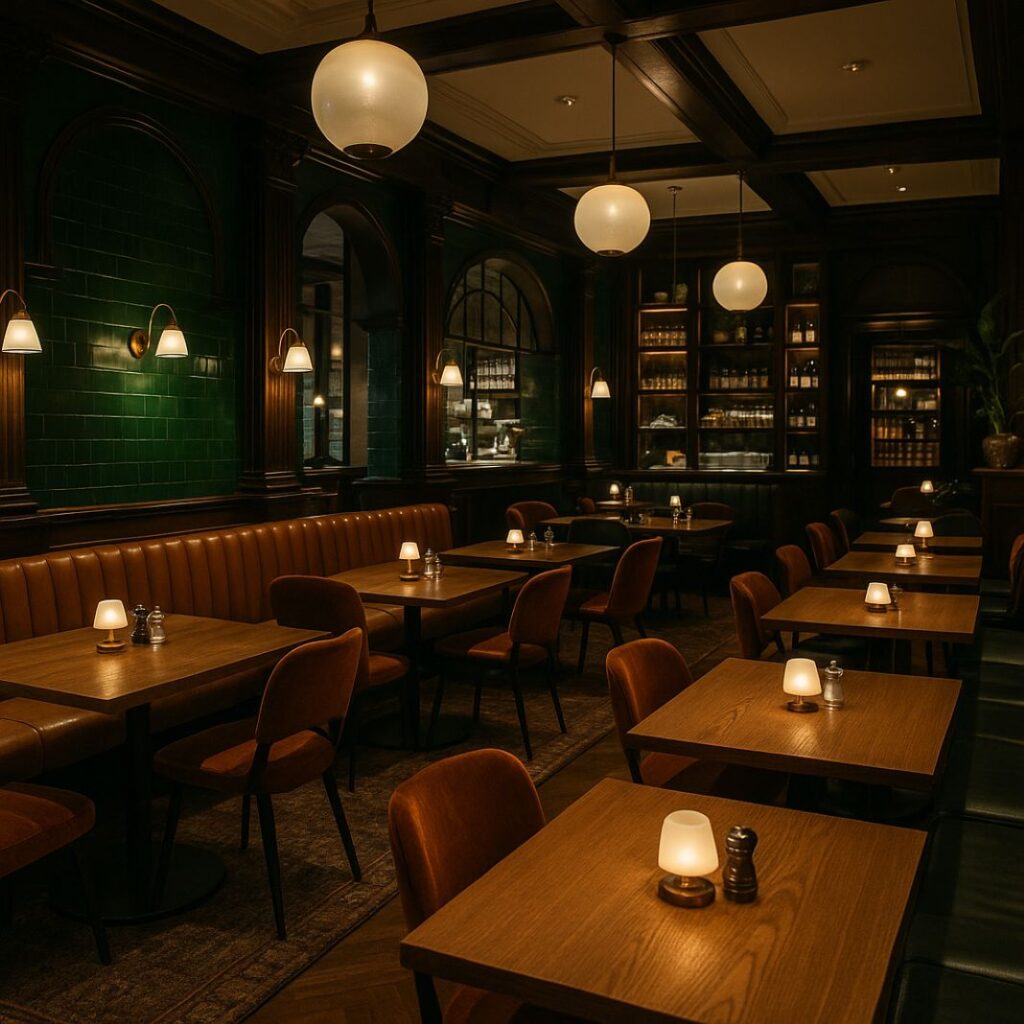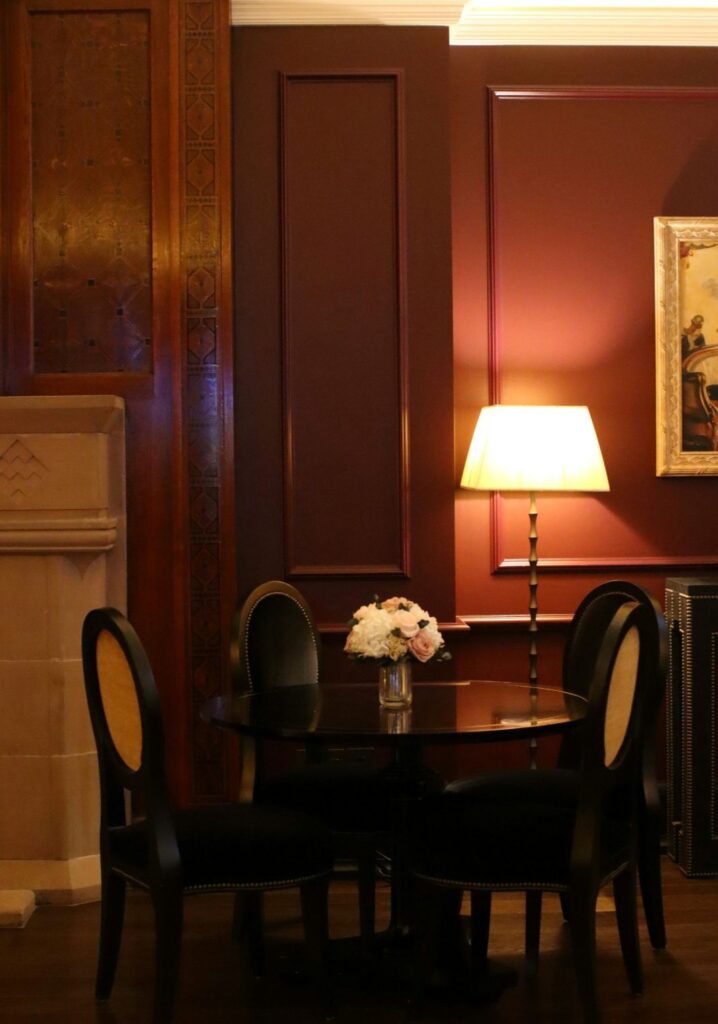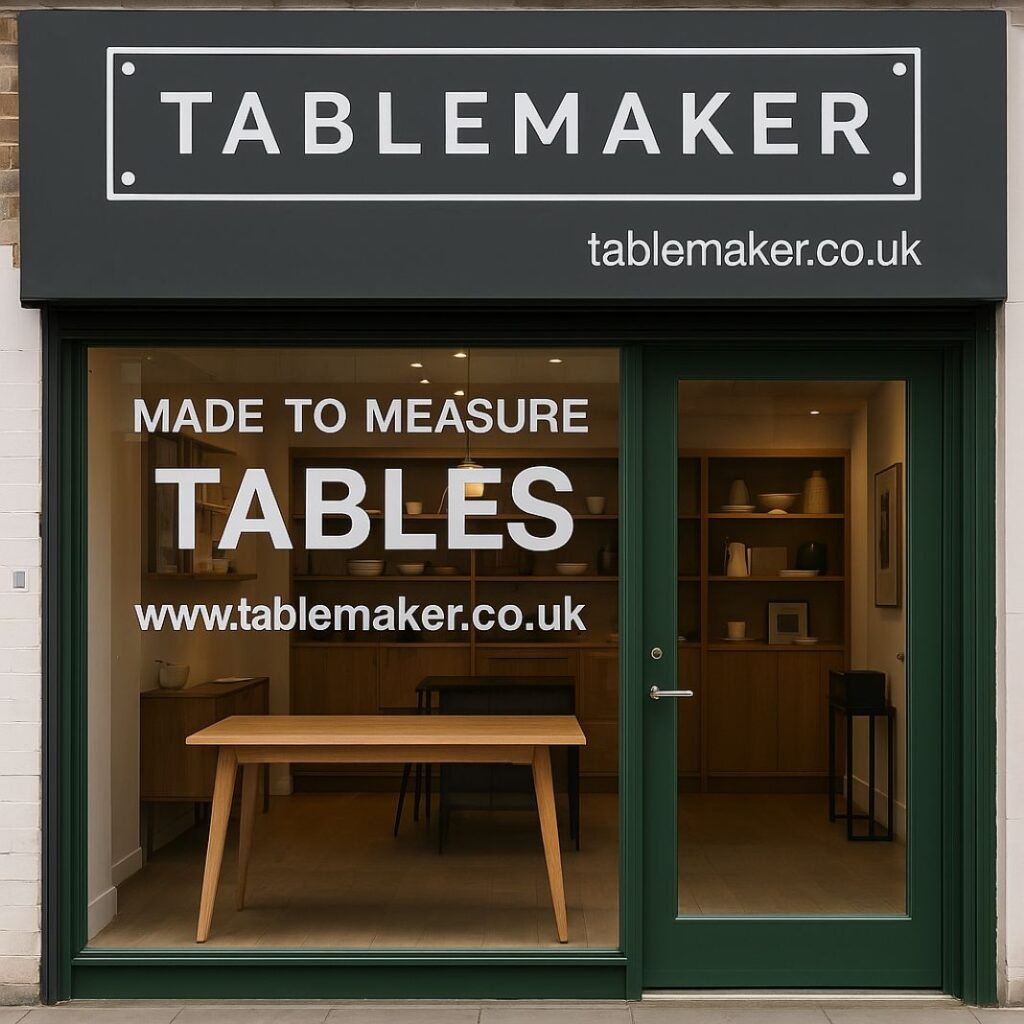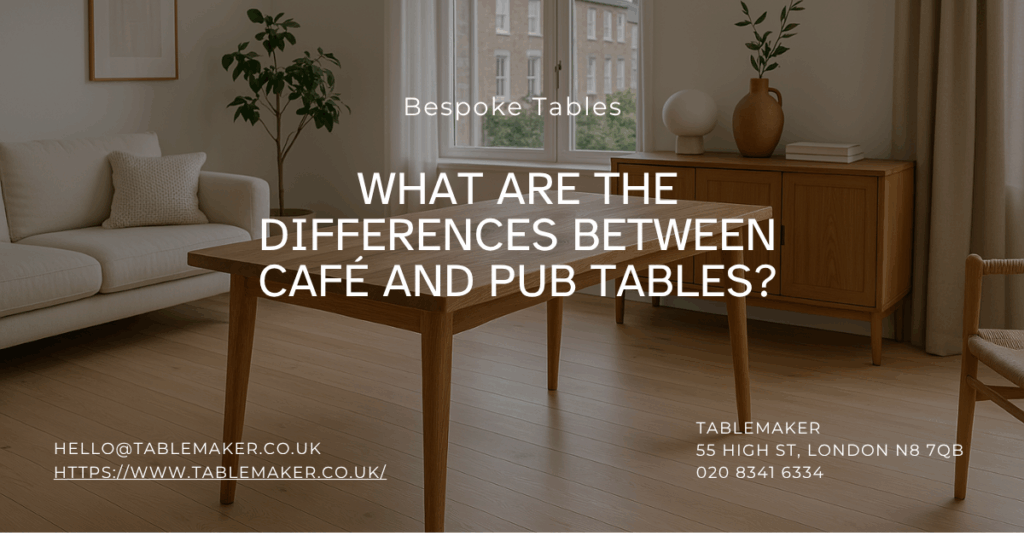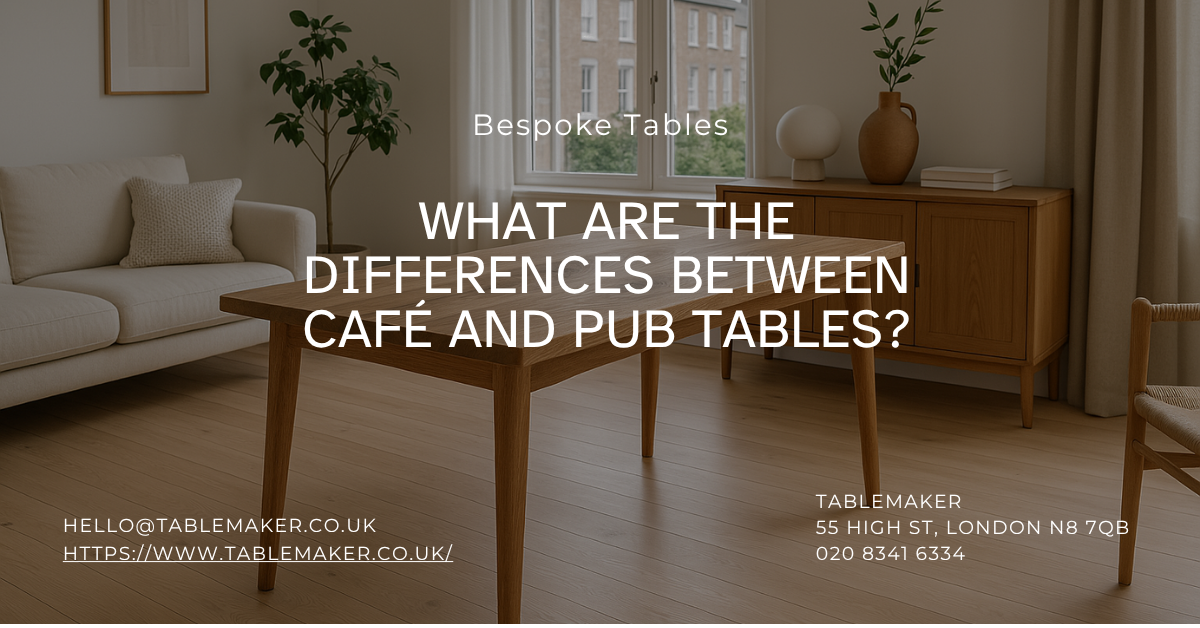
What Are the Differences Between Café and Pub Tables?
What are the key differences between café and pub tables in commercial settings?
Café and pub tables differ significantly in height, size, function, and the environments they serve. In hospitality design, choosing between the two is not just a matter of taste but a strategic decision that impacts comfort, layout efficiency, branding, and customer experience. Café tables are typically compact and suited for relaxed, short-term visits in bright, sociable settings like coffee shops and bistros. Pub tables, on the other hand, are often taller, more robust, and built for high-volume environments such as bars and gastro pubs where social interaction, standing, and longer dwell times are common.
In this article about commercial tables, we have covered
- Defining the Essentials
- Dimensions and Ergonomics
- Design Psychology and Atmosphere
- Commercial Use Cases
- Materials and Durability in Hospitality Settings
- Space Planning and Layout Design
- Aesthetic Alignment with Brand Identity
- Customisation Options for Commercial Spaces
- Compliance and Safety Considerations
- Sustainability and Environmental Responsibility
- Cost and Return on Investment
- Choosing the Right Furniture Supplier
- Final Summary
- FAQs
Defining the Essentials
What is a Café Table?
A café table is a smaller table, often between 28 to 30 inches in height, designed to fit compact spaces. These tables cater to short-term visits and casual interactions, typically paired with standard dining chairs. They encourage intimacy and efficiency, making them ideal for solo customers, couples, or fast-paced foot traffic.
What is a Pub Table?
Pub tables, also known as bar height tables, generally range from 40 to 42 inches in height. These are purpose built for social settings, often accompanied by bar stools and designed to accommodate groups. Their height encourages standing interaction and longer dwell times, making them a fixture in bars, breweries, and public houses.
Who Uses Each and in What Context?
Café tables are common in coffee shops, bakeries, and fast casual eateries where space optimisation and quick table turnover are essential. Pub tables suit establishments where patrons linger longer, such as taprooms and sports bars. Understanding these environments helps businesses plan layouts that support their operational goals.
Dimensions and Ergonomics
Typical Café Table Dimensions
Standard café tables measure around 28 to 30 inches in height and come in compact diameters, typically 24 to 36 inches. These sizes promote efficient use of space and can easily accommodate two to four guests with standard height chairs.
Pub Table Height and Ergonomics
Pub tables range from 40 to 42 inches in height, pairing with stools between 28 and 30 inches. This creates an elevated seating experience suitable for prolonged use. While sociable and practical for larger groups, the taller height necessitates careful ergonomic consideration to ensure comfort and accessibility.
Compliance and Inclusive Design
In the UK, compliance with accessibility standards is important. Ensuring a mix of table heights within a venue can support diverse customer needs. Café tables allow for easy wheelchair access, while pub tables should offer at least one lower height seating option. Providing a balance improves usability and ensures venues are inclusive to everyone.
Design Psychology and Atmosphere
How Table Design Influences Mood
The shape, height, and materials of tables affect how people feel and interact. Café tables are often designed to support calm, one to one or small group conversations. Their lower height helps create a sense of closeness and privacy. Pub tables, being taller and often shared by more people, promote conversation among groups and encourage a livelier setting.
Seating Posture and Social Habits
Sitting at a café table feels different from perching on a stool at a pub table. One is grounded and relaxed, the other is open and informal. Understanding how posture influences behaviour can help you choose tables that support your customers’ needs. For example, pubs might want to keep energy high and encourage longer stays, while cafés might prefer quicker visits and a steady turnover.
Matching the Mood to the Venue
Café tables lend themselves well to soft lighting, acoustic comfort, and warm interiors. Pub tables are often used in louder, more active spaces, sometimes complemented by wall mounted menus or sports screens. Both settings benefit from thoughtful design that supports the way people use them.
Pro Tip: If your venue experiences high footfall, choose finishes like hardwax oil that allow easy spot maintenance and refinishing without downtime.
Pro Tip: Always measure your chair or stool height in relation to table height, not just overall size. A common mismatch causes long-term discomfort for customers.
Commercial Use Cases
Where Café Tables Work Best
Café tables are well suited for coffee shops, sandwich bars, bakeries, coworking lounges, and even quiet areas within larger venues. Their small footprint makes them ideal for high footfall areas where customers tend to stay for shorter periods. They are also used in alfresco seating and casual indoor installations.
Best Settings for Pub Tables
Pub tables suit busy bar areas, taprooms, cocktail lounges, and sports pubs. They work well in places where customers like to linger, either seated or standing. The taller height suits bar stools and encourages a flow of conversation. They are also handy for accommodating shared platters and drinks rounds.
Examples of Mixed Use
It is not uncommon for modern venues to combine both types. A café might use pub tables in the window area for people watching, while a bar might include a few café height tables to cater for families, older guests, or accessibility reasons. Mixing table types can make a venue feel more welcoming and adaptable.
Materials and Durability in Hospitality Settings
Choosing the Right Materials
In commercial venues, furniture needs to withstand high levels of wear. For café and pub tables, solid oak tables such as those from a commercial furniture supplier offer strength, visual appeal, and long term reliability. Veneered chipboard may reduce initial cost but can look worn quickly.
Finishes That Last
Tables in cafés and pubs are exposed to liquids, cleaning agents, and regular use. A hardwax oil finish offers deep surface protection while maintaining a natural wood appearance. It penetrates the timber rather than forming a top coat, allowing easy spot maintenance and reapplication when required.
Maintenance and Practicality
Commercial tables must be easy to clean and feel solid when in use. Smooth surfaces reduce cleaning time and improve hygiene. Flat pack delivery is helpful for access and logistics, but strength remains essential. Traditional joinery methods increase durability and reliability even for flat packed furniture.
Space Planning and Layout Design
Optimising Table Placement in Small Cafés
In cafés under 50 square metres, spacing tables at a minimum of 750 mm apart allows comfortable movement while maximising capacity. Wall-mounted banquettes combined with small custom café tables enable flexible layouts that adapt to peak periods. Window-height bar tables can attract walk-ins looking for quick stops.
Maximising Floor Efficiency in Pubs
Pubs benefit from zoning. Use tall pub tables along the perimeter for drinkers and standing guests, and shorter café-height tables in quieter corners for diners. Central communal pub tables help with crowd dispersion during events or matches. Choosing consistent finishes ties together diverse layouts into a cohesive look.
Accessibility and Regulations
It is important to follow UK accessibility regulations when planning your space. Providing clear walkways and varied seating heights can help meet those expectations. For more on practical size advice, see our table guide or contact a commercial furniture supplier.
Aesthetic Alignment with Brand Identity
Matching Tables to Interior Themes
Choosing furniture that aligns with your brand’s visual identity strengthens how your venue is perceived. Café tables in oak or light ash with simple silhouettes complement minimalist or Scandinavian interiors. Pubs may benefit from darker finishes or chunky grain textures that echo tradition or industrial character. Colour, shape, and detailing all contribute to a cohesive brand story.
Visual Harmony Across Furniture
Using the same material across both table tops and chair frames creates a consistent look. Where contrast is used, for example with black metal legs under natural oak tops, ensure the tones are balanced and repeated elsewhere. For instance, black menu boards or pendant lights can echo the colour used on table bases, reinforcing design unity.
pub furniture for trade buyers?
From pubs to coffee shops, we support UK-wide fitouts with solid oak, made-to-order tables.
Request a QuoteCustomisation Options for Commercial Spaces
Custom Dimensions and Layout
Custom-built tables allow businesses to tailor furniture to their specific spatial needs. Whether it’s a tight café corner or a large communal space in a pub, choosing the right dimensions improves functionality and layout flow. Many suppliers, including Tablemaker, offer custom sizing, edge profiles, and base configurations.
Branding Through Finishes
Beyond size, finishes can be used to reflect a venue’s character. A natural finish may suggest simplicity and eco-awareness, while stained or painted finishes can enhance vintage, modern, or industrial themes. Some suppliers offer engraved logos or colour-matched bases to further align furniture with brand identity.
Compliance and Safety Considerations
Fire Safety and Surface Performance
Hospitality tables must comply with UK fire safety standards, particularly in enclosed public spaces. Materials and finishes should be fire-retardant or treated accordingly. Hardwax oils and commercial-grade lacquers are popular choices that meet safety without compromising appearance.
Stability and Joinery
Commercial tables are often subjected to heavy use. Choosing tables with durable joinery, such as mortise and tenon or dowel reinforced structures, can significantly improve performance. Adjustable feet also help with stability, especially in older buildings with uneven flooring.
Sustainability and Environmental Responsibility
Material Sourcing
Conscious design choices are now standard in hospitality. Tablemaker sources FSC-certified timber and low-emission finishes to support sustainability. Customers increasingly favour durable furniture over fast replacements to reduce environmental impact.
End-of-Life Planning
Unlike mass-produced furniture, solid wood tables can be sanded and refinished. This makes them more sustainable in the long term, offering customers a piece that can evolve with the venue rather than needing replacement.
Cost and Return on Investment
Upfront Cost vs Long-Term Value
Though pub and café tables vary in price, the true value comes from how well they perform and how long they last. A slightly higher investment in quality materials such as solid oak tables often results in reduced maintenance, fewer replacements, and better aesthetics over time.
Revenue Per Square Metre
Smart table selection can influence turnover and revenue. For example, smaller custom café tables may generate high turnover during peak hours, while pub tables can encourage longer stays and larger spend per head. Tailoring your table plan to your business model is vital.
Choosing the Right Furniture Supplier
What to Look For
Choose a commercial furniture supplier that offers material transparency, experience in the hospitality trade, and options for customisation. Look for reviews, lead times, and after-sales support. Suppliers like Tablemaker specialise in helping trade clients source reliable, durable furniture.
UK-Based Support
Tablemaker operates from London and provides nationwide service. Working with a local supplier can help with quick deliveries, better communication, and on-site support if needed. This is especially valuable for pubs and cafés with fitout deadlines.
Trade-Ready Custom Solutions
From small batch orders to full interior projects, working with a supplier that understands hospitality can make procurement easier. Ask about moisture-resistant finishes, flat-pack shipping, commercial leg brackets, and aftercare kits.
Final Summary
Café and pub tables do far more than provide a surface. They shape customer flow, influence dwell time, reflect your brand, and affect your venue’s atmosphere. Understanding the functional, aesthetic, and commercial differences between the two ensures you choose the right table type for your space.
For hospitality furniture that works as hard as you do, explore customisable, commercial-grade tables from Tablemaker. Built in London, made for trade.
FAQs
Are café and pub tables the same height? No. Café tables are typically 28 to 30 inches high, while pub tables are 40 to 42 inches tall.
Can pub tables be used in café settings? Yes, especially near windows or communal areas, but consider accessibility and customer comfort.
What materials last longest in commercial spaces? Solid hardwoods like oak, sealed with hardwax oil, are preferred for strength and longevity.
How can I mix table types in one venue? Create zones for different table heights, matching materials or colours to maintain consistency.
Can I order tables in custom sizes and finishes? Yes. Tablemaker offers bespoke sizing, wood types, stains, and leg styles for trade buyers.
Need Custom Café or Pub Tables?
Let us build the perfect table for your venue. Designed to match your brand, built to last.
View ShopTablemaker
55 High St, London N8 7QB
02083416334
HVQM+58 London

